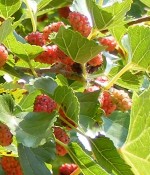 Red mulberry is a deciduous small to medium sized tree native the open woods, clearings, and roadsides from Massachusetts to Michigan, south to Florida and Texas. It is a member of the Moraceae family that also includes fig, banyan, and Osage-orange. The single stemmed trees have mahogany colored exfoliating bark and low-growing branches. The bold heart shaped leaves are quilted and six to eight inches long. They may be lobed and are dark green until turning yellow to straw colored in the fall. Catkins of inconspicuous male and female flowers are yellowish green or reddish green and usually found on separate trees in early spring. The female flowers produce red to purple compound fruits similar to a blackberry but one inch in length. The sweet juicy berries are edible and used for jam, jellies, pies and wine. They are also attractive to birds and small mammals but can be a messy when they fall to the ground so buy trees bearing male flowers only if used in an area such as a patio where the mess would be a problem. Good choice for a naturalized area. The genus name Morus is the Latin name for the tree. The specific epithet rubra comes from the Latin word ruber meaning red and refers to the color of the berries.
Red mulberry is a deciduous small to medium sized tree native the open woods, clearings, and roadsides from Massachusetts to Michigan, south to Florida and Texas. It is a member of the Moraceae family that also includes fig, banyan, and Osage-orange. The single stemmed trees have mahogany colored exfoliating bark and low-growing branches. The bold heart shaped leaves are quilted and six to eight inches long. They may be lobed and are dark green until turning yellow to straw colored in the fall. Catkins of inconspicuous male and female flowers are yellowish green or reddish green and usually found on separate trees in early spring. The female flowers produce red to purple compound fruits similar to a blackberry but one inch in length. The sweet juicy berries are edible and used for jam, jellies, pies and wine. They are also attractive to birds and small mammals but can be a messy when they fall to the ground so buy trees bearing male flowers only if used in an area such as a patio where the mess would be a problem. Good choice for a naturalized area. The genus name Morus is the Latin name for the tree. The specific epithet rubra comes from the Latin word ruber meaning red and refers to the color of the berries.
Type: Deciduous small to medium sized tree
Outstanding Feature: Bold foliage; fruit
Form: Rounded dense crown
Growth Rate: Rapid
Bloom: Inconspicuous yellowish green or reddish green male and female flowers usually on separate trees in early spring
Size: 20-60’ H x 20-40’ W
Light: Full sun to partial shade
Soil: Rich, moist, well-drained
Hardiness: Zones 5-9
Care: Low maintenance; prune if desired in late fall or winter.
Pests and Diseases: Generally healthy but susceptible to borers, whiteflies, bacterial blight, coral spot canker, bacterial leaf scorch, powdery mildew, root rot, witches broom, scale, mites, and mealybugs.
Propagation: Seeds, cuttings